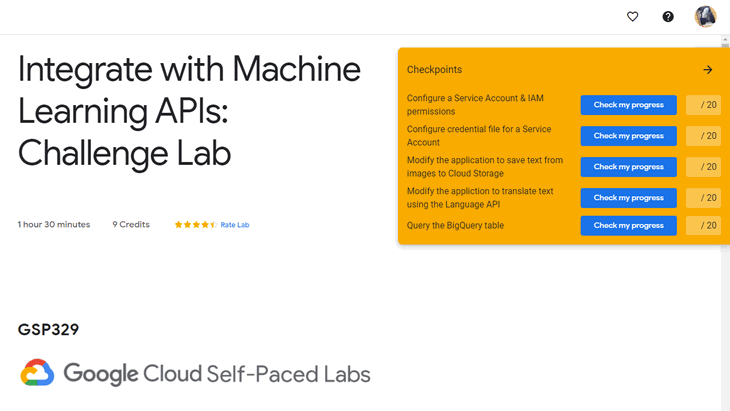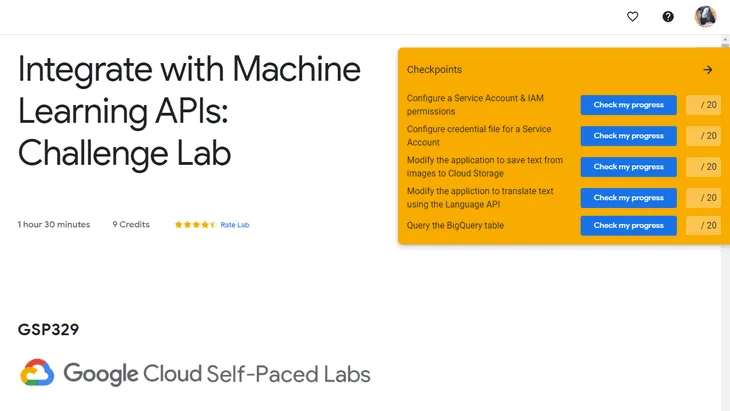☁ Integrate with Machine Learning APIs: Challenge Lab | logbook


In this article, we will go through the lab GSP329 Integrate with Machine Learning APIs: Challenge Lab, which is an advanced-level exercise on Qwiklabs. You will practice the skills and knowledge for getting service account credentials to run Cloud Vision API, Google Translate API, and BigQuery API via a Python script.
Topics tested:
- Grant the service account admin privileges for BigQuery and Cloud Storage.
- Create and download a service account credentials file to provide Google Cloud credentials to a Python application.
- Modify a Python script to extract text from image files using the Google Cloud Vision API.
- Modify a Python script to translate text using the Google Translate API.
- Check which languages are in the extracted data by executing a BigQuery SQL query.
Task 1: Configure a service account to access the Machine Learning APIs, BigQuery, and Cloud Storage
In the Cloud Shell, create a new service account that provides credentials for the script using the following commands. (Remember to replace <Your_Project_ID> with your GCP project ID)
export PROJECT=<Your_Project_ID>
gcloud iam service-accounts create my-account --display-name my-account
Tip 1. You do not need to provide any specific permissions to a service account to access most of the Google Machine Learning APIs, such as the Google Cloud Vision and Translation APIs. The Python script does need permissions to access BigQuery and to create objects in Cloud Storage. The easiest way to do that is to bind the service account to
roles/bigquery.adminandroles/storage.admin.
Once you have created the account, bind the BigQuery Admin and Cloud Storage Admin roles to the Service Account to provide the IAM permissions required to process files from Cloud Storage and insert the result data into a BigQuery table.
gcloud projects add-iam-policy-binding $PROJECT --member=serviceAccount:my-account@$PROJECT.iam.gserviceaccount.com --role=roles/bigquery.admin
gcloud projects add-iam-policy-binding $PROJECT --member=serviceAccount:my-account@$PROJECT.iam.gserviceaccount.com --role=roles/storage.admin
Task 2: Create and download a credential file for your Service Account
Run the following commands to download the JSON format IAM credentials file for the service account, and configure the name of the credential file as an environment variable.
gcloud iam service-accounts keys create key.json --iam-account=my-account@$PROJECT.iam.gserviceaccount.com
export GOOGLE_APPLICATION_CREDENTIALS=key.json
Tip 2. You must set an environment variable to provide the details of the credentials file that should be used by the Python script to access the Google Cloud APIs.
In the Cloud Console, navigate to IAM & Admin > Service Accounts to confirm the status of the service account (my-account).
Task 3: Modify the Python script to extract text from image files
Navigate to Storage in the Cloud Console, then click on the bucket name to explore the image files and the Python script that have been provided for you.
Run the following gsutil command to copy the file analyze-images.py from the Cloud Storage bucket into the Cloud Shell.
gsutil cp gs://$PROJECT/analyze-images.py .
Open the Cloud Shell Editor to review and edit the script file.
There are three unfinished parts in the script that you must complete to make the correct Machine Learning API calls. All of them are preceded with a comment using the label # TBD:. You will need to make use of the Vision API, the Translation API, and the BigQuery API. The import of the Google Cloud Library modules for the required APIs has been done in line 7 of the script file. Note down the name of their API clients that have also been declared from lines 25 to 32.
In Task 3, you need to add your codes to the following part of the script file.
Tip 3. You can find details about the Vision API Client
document_text_detectionAPI call in the Python API Documentation reference page for the Vision API Client and the details of the Vision API annotation response object in the Python API Documentation reference page for the Vision API Objects
TBD: Create a Vision API image object called image_object Ref: google.cloud.vision_v1.types.Image
image_object = vision.types.Image()
image_object.content = file_content
where file_content is the image content extracted from a JEPG or a PNG file via lines 51 and 52 of the script.
TBD: Detect text in the image and save the response data into an object called response Ref: google.cloud.vision_v1.ImageAnnotatorClient.document_text_detection
response = vision_client.document_text_detection(image=image_object)
This line uses the Cloud Vision API to extract text data from each image inside the for-loop.
Note: Make sure that you indent the codes correctly.
Task 4: Modify the Python script to translate the text using the Translation API
In Task 4, you need to add your codes to the following part of the script file.
Tip 4. For details about the Translation API Client translate API call, see the Python API Documentation for the Translation V2 API Client
TBD: For non-EN locales pass the description data to the translation API Ref: google.cloud.translate_v2.client.Client.translate
# Set the target_language locale to 'en')
translation = translate_client.translate(desc, target_language='en')
This line uses the Translation API to translate the non-English text into English.
Note: Make sure that you indent the codes correctly.
Task 5: Identify the most common non-English language used in the signs in the data set
In Task 5, you need to remove the comment characters to enable the line of code in the following part of the script.
Process the image files using the updated Python
Save the changes and then run the modified script file in the Cloud Shell:
export BUCKET=$PROJECT
python analyze-images.py $PROJECT $BUCKET
You should see an output like that:
Confirm that image data has been successfully uploaded to BigQuery
Go back to the Cloud Console, navigate to BigQuery.
Preview the table image_text_detail in the dataset called image_classification_dataset in your project.
Confirm that image data has been successfully processed by running the following Query in BigQuery:
SELECT locale,COUNT(locale) as lcount FROM image_classification_dataset.image_text_detail GROUP BY locale ORDER BY lcount DESC
The query results should look like:
Congratulations! You completed this challenge lab.
Demonstration Video
This browser does not support the YouTube video player. Watch on YouTube
⏱Timestamps:
00:00 Lab Overview
01:56 Start Lab
03:21 Confirm Cloud Vision, AutoML Translation, and BigQuery APIs are enabled
04:55 Task1: Configure a service account to access the Machine Learning APIs, BigQuery, and Cloud Storage
06:54 Task2: Create and download a credential file for your Service Account
08:05 Task3: Modify the Python script to extract text from image files
12:50 Task4: Modify the Python script to translate the text using the Translation API
14:05 Task5: Identify the most common non-English language used in the signs in the data set
14:35 Process the image files using the updated Python
17:21 Confirm that image data has been successfully uploaded to BigQuery
References:
📌 Hints for Tasks 1 - 2 Classify Text into Categories with the Natural Language API - Qwiklabs
📌 Hints for Tasks 3 - 5 Integrating Machine Learning APIs - Google Codelabs
Keep on reading:
- ☁ Automate Interactions with Contact Center AI: Challenge Lab | logbook
- ☁ Perform Foundational Data, ML, and AI Tasks in Google Cloud: Challenge Lab | logbook
Useful links: